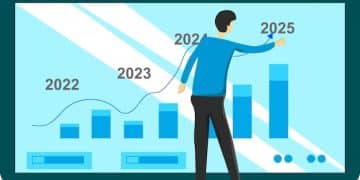Master Your 2025 Budget: Top 5 Money-Saving Apps Revealed

Navigating the complexities of personal finance in 2025 requires smart strategies, and money-saving apps offer an unparalleled solution for automating your budget, optimizing spending, and consistently achieving a 15% reduction in monthly expenses through intelligent financial management.
In an era brimming with digital solutions, the quest to master personal finance has never been more accessible. Imagine a future where your budget practically manages itself, diligently seeking out savings opportunities and trimming unnecessary expenditures. This isn’t a distant dream; it’s the reality forged by sophisticated money-saving apps designed to automate your 2025 budget and help you save a significant 15% on monthly expenses. As a seasoned financial journalist, I’ve seen countless trends come and go, but the power of these digital tools stands out as a genuine game-changer. They transform the often-tedious task of budgeting into an efficient, almost effortless, process, empowering users across the U.S. to take control of their financial destiny.
The Evolving Landscape of Personal Finance Technology
The financial technology (fintech) sector has been a whirlwind of innovation, constantly introducing tools that simplify complex financial tasks. For individuals aiming to optimize their spending and build a substantial savings cushion, the evolution of money-saving apps represents a pivotal development. These applications are no longer mere digital ledgers; they are sophisticated platforms leveraging artificial intelligence and machine learning to provide personalized insights and actionable advice. Understanding this shift is crucial for anyone looking to harness technology for tangible financial gains.
The transition from traditional budgeting methods, often involving spreadsheets or pen-and-paper tracking, to fully automated digital solutions has been incremental but profound. Early apps focused on basic expense tracking, but modern iterations offer predictive analytics, subscription management, and even automated savings transfers. This shift reflects a broader consumer demand for convenience, efficiency, and intelligence in managing personal finances. With the proliferation of digital wallets and contactless payments, detailed transaction data is readily available, allowing these apps to perform intricate analyses of spending habits.
Beyond Basic Expense Tracking
Modern money-saving apps go far beyond simply listing your expenditures. They provide a holistic view of your financial health, offering tools that can:
- Categorize spending automatically: Imagine not having to manually sort through receipts; your app does it for you.
- Identify recurring subscriptions: Pinpoint services you might have forgotten about or no longer use.
- Analyze spending patterns: Gain insights into where your money truly goes, highlighting areas for potential savings.
- Forecast future cash flow: Make informed decisions about upcoming expenses and savings goals.
The level of detail and automation these apps provide empowers users to become truly proactive about their financial management. It’s about more than just knowing what you spent; it’s about understanding why and how to spend smarter.
In essence, these tools are designed to remove the friction from financial planning. By automating data input and categorization, they free up mental energy that would otherwise be spent on tedious tasks, allowing users to focus on the strategic aspects of wealth building and debt reduction. The goal is to make budgeting effortless and, dare I say, enjoyable, transforming a chore into an empowering daily habit.
Unveiling the Top 5 Money-Saving Apps for 2025
Identifying the “best” money-saving apps often depends on individual needs, but certain platforms consistently rise to the top due to their robust features, user-friendly interfaces, and tangible impact on users’ finances. For 2025, our focus is on apps that not only track expenses but actively help automate budgeting and identify significant savings opportunities.
We’ve meticulously evaluated numerous contenders, looking for those that excel in secure data integration, insightful analytics, and actionable recommendations. The aim is to present a curated list that offers diverse functionalities, catering to different financial styles and goals, all while upholding the highest standards of user experience and security. Remember, the true power of these apps lies in consistent engagement and integrating them seamlessly into your financial routine.
1. Mint: The Comprehensive Budgeting Hub
Mint, often considered a pioneer in the personal finance app space, continues to evolve, offering a holistic view of your financial life. Its strength lies in its ability to centralize all your accounts – checking, savings, credit cards, investments, and loans – into a single dashboard. This comprehensive aggregation allows for unparalleled oversight and detailed analysis of your spending habits.
- Key Features:
- Real-time transaction tracking and categorization.
- Customizable budget creation with alerts for overspending.
- Bill tracking and payment reminders.
- Free credit score monitoring.
- Investment tracking and net worth calculation.
Mint’s intuitive interface makes it easy to set up and manage multiple budgets, whether you’re saving for a down payment or simply trying to cut down on discretionary spending. Its integration with a vast network of financial institutions solidifies its position as a go-to for comprehensive financial management. The customizable alerts are particularly useful for preventing impulse purchases and staying within set limits.
2. YNAB (You Need A Budget): The Zero-Based Budgeting Champion
YNAB takes a different approach to budgeting, advocating for a “zero-based budgeting” philosophy. This means every dollar has a job, from bills and groceries to savings goals. While it comes with a subscription fee, many users find its disciplined methodology invaluable for transforming their financial habits and achieving significant savings.
- Core Principles:
- Give every dollar a job.
- Embrace your true expenses (save for irregular bills).
- Roll with the punches (adapt your budget as needed).
- Age your money (spend money that’s at least 30 days old).
YNAB is particularly effective for those who struggle with overspending or lack clarity on where their money goes. Its proactive approach helps users build a buffer against unexpected expenses and gain a deeper understanding of their spending priorities. The initial learning curve can be steep, but the long-term benefits in financial clarity are substantial.
3. Rocket Money (formerly Truebill): The Subscription Slayer
Rocket Money has carved out a niche by focusing heavily on subscription management and bill negotiation, making it a powerful tool for discovering hidden drainages on your budget. It automatically identifies all your recurring subscriptions and offers easy ways to cancel unwanted ones directly from the app.

Beyond subscription tracking, Rocket Money also features bill negotiation services, where it can contact service providers on your behalf to try and lower your monthly bills for things like internet or cable. This unique feature can result in significant, passive savings without much effort on your part.
Often, individuals are unaware of the cumulative cost of their subscriptions, which can silently erode a substantial portion of their income. Rocket Money excels in bringing this obscured spending to light and providing immediate solutions. Its intelligent algorithms learn your spending habits and can flag unusual or duplicate charges, adding another layer of financial protection.
4. Personal Capital: Investment & Wealth Management Focus
While many money-saving apps focus primarily on budgeting and expense tracking, Personal Capital offers a robust suite of tools primarily aimed at wealth management and investment analysis. It’s ideal for individuals with a more complex financial portfolio, helping them track their net worth, analyze investment performance, and plan for retirement.
- Financial Power Tools:
- Net worth tracking across all accounts.
- Investment portfolio performance analysis.
- Retirement planning and fee analyzer.
- Budgeting tools that integrate with investment goals.
Personal Capital’s free financial dashboard is exceptionally powerful, providing detailed insights into your assets and liabilities. For those seeking professional guidance, it also offers paid financial advisory services, making it a comprehensive platform for both self-directed and advised wealth management. Its ability to aggregate diverse investment accounts provides a consolidated view that is often missing from other budgeting tools.
5. Simplifi by Quicken: Streamlined Budgeting for Modern Users
Simplifi by Quicken is designed for those who desire powerful budgeting capabilities without the complexity of traditional Quicken software. It offers a cleaner, more modern interface with a strong emphasis on smart spending plans and cash flow management. Simplifi helps users proactively avoid overspending and easily track progress towards savings goals.
Its “Watchlist” feature allows you to keep an eye on specific spending categories, ensuring you don’t exceed self-imposed limits. Simplifi also provides personalized spending insights, helping you understand where you can cut back without feeling deprived. It integrates seamlessly with bank accounts and credit cards, offering automated categorization and real-time updates on your financial position.
This app shines in its ability to offer powerful financial tools in an accessible format. It intelligently identifies recurring transactions and suggests budgets based on your actual income and spending, making the budgeting process highly realistic and achievable. Simplifi is an excellent choice for users who want robust features but prefer a more streamlined, app-centric experience over desktop software.
Automating Your Budget: The Path to 15% Savings
The true magic of these money-saving apps lies in their automation capabilities. Setting up your budget is just the first step; the continuous tracking, analysis, and adjustment are where significant savings are realized. Automating these processes transforms budgeting from a manual chore into an empowering, background operation that actively works towards your financial goals.
Imagine your app automatically categorizing every transaction, flagging potential overspends, and even suggesting adjustments based on your income fluctuations. This level of automation means you don’t have to devote hours each week to spreadsheet updates or receipt sorting. The app does the heavy lifting, providing you with clear, digestible insights that enable smart decisions, pushing you closer to that 15% savings target.
Leveraging Automation for Consistent Savings
To achieve a substantial 15% reduction in monthly expenses, you need more than just awareness; you need consistent action. Automation facilitates this by:
- Real-time expense tracking: No more waiting until the end of the month to see where your money went.
- Budget alerts: Get notified instantly when you’re nearing or exceeding a budget category.
- Subscription management: Automatically identify and often cancel unwanted recurring charges.
- Savings automation: Set up automatic transfers to savings accounts based on your budget and financial goals.
These features combine to create a financial ecosystem where your money is constantly being optimized. Whether it’s finding a cheaper car insurance rate, cancelling an unused gym membership, or simply nudging you to pack lunch instead of eating out, the cumulative effect of these small, automated changes can be profound.
Furthermore, many apps offer “round-up” features, where spare change from purchases is automatically transferred to a savings account. While seemingly small, these micro-savings can accumulate over time, contributing significantly to your overall savings goals without requiring conscious effort. The beauty of automation is its ability to make saving a default setting rather than a difficult decision.
Maximizing App Features for Optimal Financial Health
Simply downloading a money-saving app isn’t enough; actively engaging with its features is paramount to realizing its full potential. To achieve that coveted 15% saving target and beyond, users must be proactive in setting up, monitoring, and adjusting their financial plans within these digital environments. It’s about turning passive data collection into active financial management, fostering habits that lead to long-term economic well-being.
Understanding the nuances of each app’s capabilities allows for a more tailored and effective approach to budgeting. For instance, an app’s ability to negotiate bills won’t benefit you if you don’t grant it the necessary permissions or review its suggestions. Similarly, personalized insights only become valuable when you act upon them, making conscious choices based on the data presented.
Advanced Tactics for App Utilization
Beyond basic tracking, consider these strategies to deepen your engagement and maximize savings:
- Regularly review spending reports: Don’t just glance at the dashboard; deep dive into weekly or monthly reports to identify persistent problem areas.
- Set realistic, yet challenging, goals: While 15% is a great starting point, consider pushing for more as you become more financially savvy.
- Experiment with different budgeting methods: Some apps support envelope budgeting, zero-based budgeting, or the 50/30/20 rule. Find what resonates with you.
- Utilize bill negotiation services: For apps like Rocket Money, leverage their ability to reduce recurring expenses.
By treating your money-saving app not just as a tool, but as a financial coach, you can unlock its full power. These applications are designed to empower you with information, but the ultimate decision-making and commitment to saving rests with you. The combination of intelligent software and informed human action is what truly drives financial success.
For example, if an app highlights excessive spending on dining out, instead of completely cutting it, you might challenge yourself to reduce it by 30% first. This iterative approach makes financial adjustments feel less restrictive and more achievable. Many apps also offer educational resources or community forums, providing additional support and strategies to optimize your financial journey.
Security and Privacy Considerations for Financial Apps
In an age where data breaches are unfortunately common, the security and privacy of your financial information are paramount when using money-saving apps. Entrusting an application with access to your bank accounts and credit card details requires a high degree of confidence in its protective measures. Responsible financial journalists emphasize the need for users to be fully informed about how their data is handled and secured.
While the apps we’ve highlighted employ robust security protocols, including bank-level encryption and multi-factor authentication, it’s always wise for users to take their own precautions. This includes using strong, unique passwords, enabling all available security features, and being vigilant about phishing attempts. A secure digital environment is a shared responsibility between the app provider and the user.
Ensuring Your Financial Data is Safe
Before committing to any money-saving app, consider these crucial security and privacy aspects:
- Encryption standards: Verify the app uses bank-level encryption (e.g., 256-bit AES) for data transmission and storage.
- Multi-factor authentication (MFA): Always enable MFA for an extra layer of security on your account.
- Data handling policies: Read the privacy policy to understand how your data is collected, used, and shared (or not shared).
- Reputation and reviews: Choose apps with a long-standing positive reputation and strong security track record.
Most reputable money-saving apps adhere to strict industry standards and often undergo regular security audits. They typically connect to your financial institutions using read-only access, meaning they can view transaction data but cannot initiate transfers or payments. This read-only permission significantly reduces the risk of direct financial loss in the event of a breach.
Furthermore, staying informed about updates and security patches released by the app developer is important. Enabling automatic updates ensures you always have the latest protections in place. While no system is entirely impervious to threats, choosing apps that prioritize security and practicing good digital hygiene can significantly minimize risks and ensure peace of mind as you automate your finances.
Looking Ahead: The Future of Automated Savings in 2025 and Beyond
As we navigate further into 2025, the capabilities of money-saving apps are only expected to grow, becoming even more integrated, intelligent, and influential in our financial lives. The trajectory of fintech suggests a future where personal finance management will be even more seamless, intuitive, and predictive, pushing beyond the current automation capabilities to truly anticipate our needs and optimize our spending without constant manual input. This evolution promises to make the 15% monthly savings target an easily achievable baseline for many households.
Imagine apps that not only track and categorize but also proactively suggest optimal times for large purchases based on market trends, or automatically rebalance investments according to personalized risk assessments. The integration of AI and machine learning will become even more sophisticated, offering hyper-personalized financial coaching and even anticipating future financial challenges before they arise. The goal is to move towards a truly “set it and forget it” financial management style, where the app acts as a highly intelligent, ever-vigilant financial assistant.
Emerging Trends in Financial Automation
Several exciting trends are poised to shape the future of money-saving apps:
- Hyper-personalization: AI-driven insights that are uniquely tailored to individual spending habits, preferences, and long-term goals.
- Gamification of savings: Integrating game-like elements to make saving money more engaging and rewarding.
- Predictive analytics: Apps will become better at forecasting future expenses and income, helping users prepare for financial fluctuations.
- Enhanced security features: Continuous innovation in biometric authentication and fraud detection to protect user data.
- Integration with other lifestyle apps: Seamless connections with shopping, travel, and wellness apps to offer more holistic savings opportunities.
Moreover, we can anticipate a greater emphasis on ethical AI in financial services, ensuring transparency in how algorithms make recommendations and protect consumer data. Regulatory frameworks will also likely evolve to keep pace with these technological advancements, aiming to safeguard consumer interests while fostering innovation. The future of automated savings isn’t just about technology; it’s about creating a more financially secure and empowered populace.
The proliferation of Open Banking initiatives, where consumers can securely share their financial data with third-party providers, will further fuel this innovation. This will enable a new generation of apps that can offer even more integrated and comprehensive financial solutions, transcending traditional banking boundaries. The focus will increasingly shift from merely managing money to actively growing wealth and achieving complex financial objectives with intelligent assistance.
| Key Feature | Brief Description |
|---|---|
| 💰 Automated Budgeting | Apps track and categorize expenses, providing real-time financial oversight. |
| 🎯 Savings Goal Tracking | Monitor progress towards financial goals like debt reduction or significant purchases. |
| ✂️ Subscription Management | Identify and manage recurring subscriptions, helping to cut unwanted services. |
| 🛡️ Enhanced Security | Bank-level encryption and MFA protect sensitive financial data across platforms. |
Frequently Asked Questions About Money-Saving Apps
Money-saving apps achieve this by automating budgeting, categorizing spending, and identifying wasteful habits such as unused subscriptions. They provide real-time insights into your financial behavior, offering alerts for overspending and opportunities to negotiate bills. This comprehensive overview and proactive management empower users to make informed decisions and cut unnecessary costs, leading to significant savings over time.
Yes, reputable money-saving apps typically employ bank-level encryption (e.g., 256-bit AES) and multi-factor authentication (MFA) to protect your financial data. Most use read-only access to your accounts, meaning they can view transactions but cannot initiate transfers. It’s crucial to choose well-established apps with strong security reputations and always use robust, unique passwords.
Mint offers a comprehensive overview of your financial health, including budgeting, credit score, and investments, with a focus on ease of use. YNAB champions a “zero-based budgeting” philosophy, assigning every dollar a job, which requires more discipline but can lead to profound behavioral changes. Mint is generally free, while YNAB is a paid subscription. Choose Mint for broad oversight, YNAB for strict budgeting discipline.
These apps automate a significant portion of budgeting, including transaction categorization and tracking. While initial setup requires some input, ongoing management is largely automated, with personalized alerts and insights. Some apps even automate savings transfers or bill negotiation. The goal is to minimize manual effort, allowing you to focus on strategic financial decisions rather than tedious data entry.
If you have specific needs, consider features like investment tracking (Personal Capital), subscription management (Rocket Money), or robust debt payoff trackers. Look for apps with strong customer support, a user-friendly interface, and compatibility with all your financial accounts. Reading user reviews and focusing on apps that align with your unique financial goals and budgeting style is always recommended.
Conclusion
Embracing the power of money-saving apps is no longer just a convenience; it’s a strategic imperative for anyone serious about optimizing their finances in 2025. As demonstrated, tools like Mint, YNAB, Rocket Money, Personal Capital, and Simplifi by Quicken offer diverse yet equally effective pathways to achieving substantial savings, automating your budget, and ultimately securing your financial future. By leveraging their intelligent features—from real-time expense tracking and budget alerts to subscription management and investment analysis—you can seamlessly integrate financial discipline into your daily life. The goal of saving 15% on monthly expenses is not just attainable; it’s an easily sustainable reality when supported by these innovative digital assistants, empowering you to maintain control and clarity over your financial journey.





